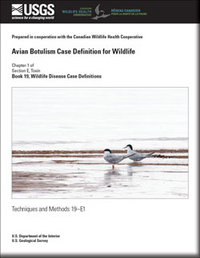Avian Botulism Case Definition for Wildlife
Links
- Document: Report (3.8 MB) , HTML , XML
- Larger Work: Case definitions for wildlife diseases
- Download citation as: RIS | Dublin Core
Abstract
Diagnostic laboratories receive carcasses and samples for diagnostic evaluation and pathogen/toxin detection. Case definitions bring clarity and consistency to the evaluation process. Their use within and between organizations allows more uniform reporting of diseases and etiologic agents.
The intent of a case definition is to provide scientifically based criteria for determining (a) if an individual carcass has a specific disease and degree of confidence in that diagnosis and (b) if there is evidence of a pathogen or toxin in a carcass or sample (for example, swab, tissue sample, skin scraping, blood/serum sample, environmental sample, or other). This case definition is specific to avian botulism and applies to all avian species.
Suggested Citation
Lankton, J.S., and Stevens, B., 2024, Avian botulism case definition for wildlife: U.S. Geological Survey Techniques and Methods, book 19, chap. E1, 8 p., https://doi.org/10.3133/tm19E1.
ISSN: 2328-7055 (online)
Table of Contents
- Acknowledgments
- Introduction
- Scope of the Case Definition
- Case Definition Criteria
- Case Classification
- Quality-Assurance Review Schedule
- Impact
- References Cited
- Glossary
| Publication type | Report |
|---|---|
| Publication Subtype | USGS Numbered Series |
| Title | Avian botulism case definition for wildlife |
| Series title | Techniques and Methods |
| Series number | 19-E1 |
| DOI | 10.3133/tm19E1 |
| Publication Date | March 15, 2024 |
| Year Published | 2024 |
| Language | English |
| Publisher | U.S. Geological Survey |
| Publisher location | Reston, VA |
| Contributing office(s) | National Wildlife Health Center |
| Description | v, 6 p. |
| Online Only (Y/N) | Y |
| Additional Online Files (Y/N) | N |


